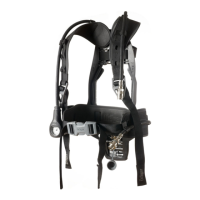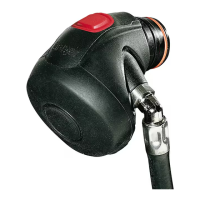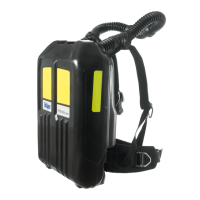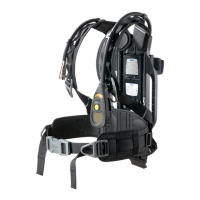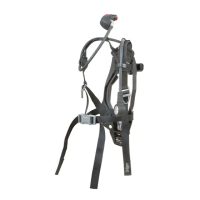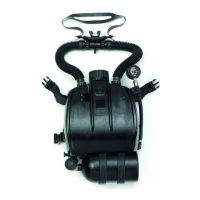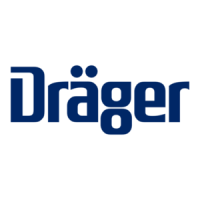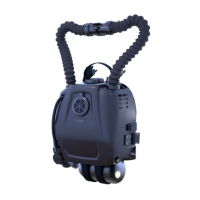CAUTION
Donotapplyexcessiveforceorusetoolstoopenorcloseacylindervalve,and
donotdroporthrowdownthebreathingapparatus.
Refer to the following additional information before preparing or using the breathing
apparatus:
● Thespecialinstructions(seeSection9).
● TheNIOSHApprovalLabel3359026forapprovedcongurations.
3.1 Preparation for use
i
i
NOTICE
The face of the pressure gauge may be tted with a thin exible protective
covering.Removethiscoveringbeforerstuse.
1. Carryoutavisualinspectionofthebreathingapparatus(seeSection3.5.1).
2. Fittheaircylinder(seeSection3.5.2).
3. Pressthemalecouplingofthelungdemandregulatorhoseintothefemalecouplingof
themedium-pressurehoseuntilanaudibleclickisheard(donotconnecttheregulator
tothefacemaskatthisstage).
4. Pressthe resetbutton (Fig 2,Item 1) toswitch offthepositive pressure. Pressand
rotatethe bypassbutton (Fig2, Item 3)to alignthe red spotsand thenrelease the
buttontoswitchoffthebypass.
5. Carryoutafullfunctionaltestoftheapparatus(seeSection3.5.3).
6. Alignandpushthelungdemandregulatorintofacemaskportuntilitlatchesinposition,
andchecktheattachmentbygentlyattemptingtopullthecouplingapart.
3.2 Putting on the breathing apparatus
1. Fullyloosentheshoulderstrapsandwaistbeltandputonthebreathingapparatus.
2. Checkthattheshoulderpadsarenottwistedandtaketheweightofthesystemonthe
shouldersbypullingtheshoulderstraps.Donotfullytightenatthisstage.
3. Closethewaistbeltbuckleandpulltheendsofthewaistbeltuntilittssecurelyand
comfortably(Fig3).Tuckthebeltendsbehindthewaistpadorbelt.
4. Pulltheshoulderstrapsuntilthebreathingapparatusrestssecurelyandcomfortablyon
thehips.Donotovertighten.Tuckthebeltendsbehindthewaistpadorbelt.
5. Fullyloosentheheadstrapsofthefacemaskandplacetheneckstrapovertheback
oftheneck.
6. Presstheresetbutton(Fig2,Item1)toswitchoffthepositivepressure.
7. Openthecylindervalve(counterclockwise)slowly,butfully,topressurizethesystem.
8. Putonthefacemaskandcheckfortightt(seetheInstructionsforUsesuppliedwith
thefacemask).
3.3 During use
!
WARNING
Fullyopenthecylindervalveandensureitremainsopenduringuse.
Usersshould be inasafe area beforetheend-of-service time (EOST)whistle
warning commences. Evacuate to a safe area immediately if the warning
commencesduringanoperation.
Usingthebypassbutton(Fig2,Item3)willuseairfromthecylinderandrapidly
reducetheworkingdurationoftheapparatus.
● Regularlychecktheremainingcylinderpressureonthegauge.
● Ifadditionalairisrequired,brieypressandreleasethebypassbutton(Fig2,Item3)to
deliverasinglejetofairintothefacemask.
!
WARNING
The emergency air ow procedures below may greatly reduce the operating
durationoftheairsupply.Whenactivatedtheusermustimmediatelyevacuate
to a safe area.The reason for usingthe procedure must be investigated and
repairedbeforereusingtheapparatus.
● Additionalairowrequired(emergencyprocedureonlyusedintheunlikelyconditionof
loworblockedairow)–Pressandrotatethebypassbutton(Fig2,Item3)todelivera
sustainedairsupply(85to130liters/minute)intothefacemask.
● Excessiveorlossofairow(emergencyprocedureonlyusedintheunlikelycondition
ofhighorlossofairow)–Closethecylindervalvethenimmediatelybegintoslowly
reopenthevalve.Usethecylindervalveasaregulatingvalvetosettheairowtomeet
theuserrequirement.This procedure canbeused with screw-typeandratchet-type
cylindervalves.
3.4 After use
!
WARNING
Donotremovethebreathingapparatusuntilinasafebreathingenvironment.
1. Loosen the face mask straps. As the seal between the face mask and the face is
broken,presstheresetbutton(Fig2,Item1)toswitchoffthepositivepressure.Fully
removethefacemaskandextendallofthestrapsoftheheadharness.
2. Closethecylindervalve.
3. Pressthefrontbutton(Fig2,Item2)toventsystem andthenpresstheresetbutton
(Fig2,Item1)toswitchoffthepositivepressure.
4. Releasethewaistbeltbuckle.
5. Lifttheshoulderstrapbucklestoloosenthestraps.
6. Removethebreathingapparatusandfacemask.
7. Carryouttheafterusetasksinthemaintenancetable(seeSection5.1).
8. Removetheaircylinderifrequired(seeSection3.5.2).
9. Passthe breathing apparatustothe service departmentwithdetails of anyfaultsor
damagethatoccurredduringuse.
7
3111
1
2
3
3.5 Common user tasks
3.5.1 Visual inspection
Avisualinspectionmustcheckthefullbreathingapparatusincludingallcomponentparts
and accessories. Check that the equipment is cleanand undamaged,paying particular
attentiontopneumaticcomponents,hosesandconnectors.Typicalsignsofdamagethat
may affect the operation of the breathing apparatus include impact, abrasion, cutting,
corrosion and discoloration. Report damage to service personnel and do not use the
apparatusuntilfaultsarerectied.
3.5.2 Aircylinderttingandremoving
!
WARNING
High-pressureairreleasemaycauseinjurytotheuserorotherpersonnelnear
thebreathingapparatus.Closethecylindervalveandfullyventthesystembefore
attemptingtodisconnectanaircylinder.
Impact damage to the cylinder valve or rst-stage regulator connector may
prevent valve connection or cause an air leak. Handle the air cylinder and
breathingapparatuswithcare.
i
i
NOTICE
The following instructions are for a CGA-type threaded cylinder coupling. For
othercylinderconnectortypes,refertotheInstructionsforUsesuppliedwiththe
connector.
Fitting the cylinder
1. Checkthethreadsofthecylindervalveportandtherst-stageregulator.Ensurethat
theO-ringseal(Fig4,Item1)intheregulatoriscleanandundamaged.
2. Lay the apparatus horizontal, with the regulator uppermost, and fully extend the
cylinderstrap.
3. Insertthecylinderthroughtheloopofthestrap,andalignthevalvewiththeregulator.
4. Liftthecylinderandspaceframeintotheverticalposition(supportedontheendofthe
cylinderoppositethevalve).
5. Tightenthehandwheeloftheregulator,usingonlythethumbandindexnger,untila
denitemetal-to-metalcontactisfelt.Donotusetoolsorovertighten.
6. Placetheunitbackintothehorizontalposition.
7. Takeuptheslackinthecylinderstrap(Fig5).
8. Pullthestrapoverthecylindertooperatethecamlock(Fig6).
9. Securethestrapendusingthecylinderstrapretainer(Fig7).Releasethecamlockto
adjustthepositionofthecylinderstrapretainerifnecessary.
Removingthecylinder
1. Close the cylinder valve and press the front button (Fig 2, Item 2) to fully vent the
system.
2. Laytheapparatushorizontal,withthecylinderuppermost.
3. Liftthecylinderstrapretainer.
4. Liftthestrapagainstthecamlocktoreleasethebuckletension,andthenloosenthe
strap.
5. Disconnectthecylindervalvefromtherst-stageregulator.
6. Liftthecylinderawayfromtheregulatorandremovethecylinder.
3.5.3 Functional testing
!
WARNING
Failureofthebreathingapparatusto meet anyofthestandardsorparameters
described in the functional tests indicates a system fault. Report the fault to
trainedservicepersonnelorcontactDräger.Donotusethebreathingapparatus
untilthefaultconditionisrectied.
Assemblethebreathingapparatusasdescribedinthepreparationforuse(seeSection3.1)
beforecommencinganyfunctionaltesting.
Leak test and whistle warning test
1. Pressthe resetbutton (Fig 2,Item 1) toswitch offthepositive pressure. Pressand
rotatethe bypassbutton (Fig2, Item 3)to alignthe red spotsand thenrelease the
buttontoswitchoffthebypass.
2. Open the cylinder valve (counterclockwise) slowly, but fully, to pressurize system.
Duringpressurizationamomentarysoundingofthewhistlewilloccur.
3. Fullyclosethecylindervalve.
4. Afteroneminute,checkthecontentsgaugeandthenreopenthecylindervalve.The
gaugemustnotshow an increaseinpressureofmore than 200psi.Ifthepressure
increaseismorethan200psi,investigateandrepairthefault(seeSection4),andthen
repeattheleaktest.
5. Fullyclosethecylindervalve.
6. Covertheoutletportofthelungdemandregulatorwiththepalmofthehandandpress
thefrontbutton(Fig2,Item2)toswitchonthepositivepressure.
7. Carefullyliftthepalmofthehandtoslowlyventthesystemuntilthewhistleactivates,
andobservethepressuredisplayedonthegauge.
8. Thewhistlemustbegintosoundintherange:
2216psicylinder:600psito510psi
4500psicylinder:1215psito1035psi
9. Continuetoventthesystemuntilfullyexhausted.
10.Presstheresetbutton(Fig2,Item1)toswitchoffthepositivepressure.
2 Description
2.1 Productoverview
The Dräger PSS
®
3000 Series is a self contained breathing apparatus (SCBA) that
providesthe wearerwith respiratoryprotection using anopen-circuit, pressure-demand,
compressed-airsystem.Theapparatuscanbeusedasaself-containedsystem,orwithan
independentairsupplyforsupplied-airrespirator(SAR)operations.Theseriesiscompatible
withawiderangeofcompressed-aircylinders,facemasksandlungdemandregulators
(e.g.FPS 7000and Panorama Novaface masks,Dräger lung demandregulators, and
aluminumorcompositecylinders).
2.2 Feature description
Thecarryingsystem uses alightweightpolymer-compositespaceframe (Fig 1,Item3).
Theshoulderstrapsandwaistbeltarefullyadjustableandusewebbingharnessstrapsand
mouldedpaddingontheshoulderpadsandwaistpad.
The apparatus uses the Dräger high-performance rst-stage regulator (6) that reduces
cylinder pressure and supplies breathing air through a medium-pressure hose (5) and
coupling(1)toanattachedlungdemandregulator.Theapparatusisttedwithamechanical
pressuregauge(4)thatincorporatesanend-of-servicetime(EOST)whistlethatsoundsto
warnthewearerthatthereislowcylinderpressure(seeSection8fortheEOSTactivation
pressures).Adual-pressurehose(7)suppliesairtothewhistle when it isactivated,and
hasaninternalcapillarytubethatsupplieshigh-pressureairfromthecylindertothegauge.
Theairhosesandtherst-stageregulatorareintegratedintothespaceframetoprevent
snagging and enhance component protection. The hose clips (2) hold the air hoses in
positionontheshoulderstraps.
Breathing apparatus serial number
Thebreathingapparatusserialnumberisontherst-stageregulator.
Compressed-air cylinders, lung demand regulators and face masks
TheDrägerPSS3000Seriesiscompatiblewithasinglealuminumorcompositematerial
cylinderof30to60minutecapacity,andisavailablein2216psior4500psiversions.Full
descriptionsanduserinstructionsarecontainedinseparateinstructionssuppliedwiththe
cylinder,facemaskorlungdemandregulator.
2.3 Intended use
The PSS 3000 Series breathing apparatus, when tted with a cylinder, lung demand
regulatorandfacemask,isintendedforuseinapplicationswhereahighlevelofrespiratory
protection is required. The assembled breathing apparatus provides the wearer with
respiratoryprotectionforworkingincontaminatedoroxygen-decientconditions.
The cylinder, lung demand regulator, face mask and other accessories used with this
productmustbe certied Drägercomponents,assembled in anapprovedconguration,
otherwise the operation of the device may be impaired. Contact Dräger for further
information.
2.3.1 Limitation
Thisproductisnotapprovedtoprovideprotectionfrommilitarygradechemical,biological,
radiological,andnuclearhazards(CBRN).Donotattempttousetheproductforrespiratory
protectioninCBRNenvironments.
2.4 Approvals
TheDrägerPSS3000SeriesiscertiedbyNIOSH.Theapparatusmustonlybeusedin
conjunctionwithcompressed-aircylindersapprovedbyNIOSH.
2.5 Explanation of marking and symbols
Refertotherelevantauthorityforexplanationofapprovalbodysymbolsandmarkingonthe
equipment.Examplesofothermarkingoncomponentpartsofthebreathingapparatusare:
BRAC-1359 – Drägerserialnumber
08/09 – Monthandyearofmanufacture
3356812orR21034 – Drägerpartnumber
SF – Standardforcecoupling
LF – Lowforcecoupling
